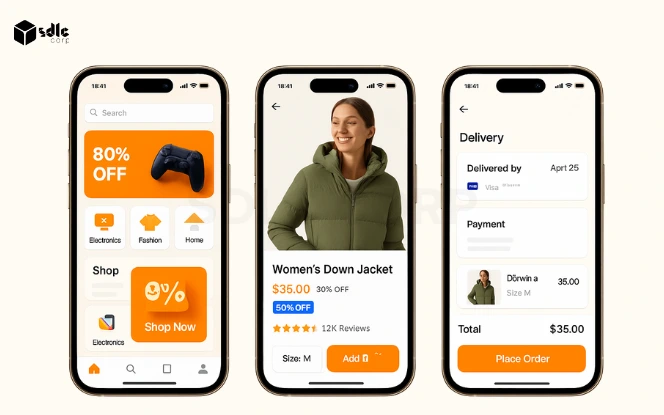In just a few years, Temu has disrupted the global e-commerce market with its unbeatable pricing, viral social engagement, and intuitive mobile-first design. Launched as a subsidiary of Pinduoduo, it leverages a powerful supply chain model that connects Chinese manufacturers directly with end-users, cutting costs and boosting margins.
Temu’s success presents a huge opportunity for entrepreneurs and retailers looking to enter the online retail space with a similar approach. But what does it cost to develop an app like Temu? What features, technologies, and processes are required to create a scalable, intuitive, and gamified online shopping experience?
This comprehensive guide covers everything from core features, development costs, design strategy, and technology stack, to timelines and challenges. If you’re serious about launching the next big online shopping app, read on.
Understanding Temu’s Business Model
Temu runs on a cross-border, direct-from-manufacturer model that dramatically reduces pricing for consumers. Here’s how:

- Direct Sourcing: Temu sources goods directly from manufacturers, eliminating intermediaries.
- Bulk Distribution: High order volume enables price slashing and better shipping deals.
- Gamification & Referral: Users engage in “Spin & Earn”, referral discounts, and flash deals.
- AI Personalization: Every user sees a uniquely tailored shopping experience based on behavior.
This model’s success lies in data science + user engagement + low-cost logistics, offering a highly optimized and viral shopping platform.
Key Features of an App Like Temu
To replicate Temu’s functionality and appeal, you need a comprehensive feature list for all users involved customers, admins, and sellers.

Gamified Shopping Experience – Features like spin-the-wheel, flash deals, and referral rewards boost user engagement and retention.
AI-Driven Personalization – Real-time product recommendations and dynamic pricing tailored to user behavior.
Seamless Checkout & Multi-Payment Support – One-tap checkout with multiple payment gateways, wallets, and cashback options.
Direct Manufacturer Sourcing – Enables lower pricing by eliminating intermediaries and optimizing supply chain efficiency.
Mobile-First, Intuitive UI/UX – Designed for quick navigation, visually engaging product listings, and fast purchase flow.
1. Customer App Features

- Onboarding & Social Login
- Advanced Search & Filters
- Product Listing and Review System
- Dynamic Pricing & Flash Sales
- Shopping Cart and Smart Checkout
- Order Tracking with Live Status
- Wishlist & Personalized Suggestions
- Referral Bonuses & Reward Systems
- AI Chatbot for Support
- Push Notifications
2. Admin Panel Features

- Vendor Management
- Order & Refund Dashboard
- Commission Management
- User Analytics and Behavior Reports
- Coupons & Promotions Panel
- Inventory and Category Controls
3. Vendor (Seller) Panel

- Product Listing & Bulk Uploads
- Order Management Tools
- Revenue Analytics
- Chat with Buyers
- Inventory Tracker
Bonus: Gamification Features
- Spin-the-Wheel Offers
- Daily Login Bonuses
- Invite-and-Earn Programs
- Mystery Boxes and Lucky Draws
These features are designed to keep users coming back and increase AOV (Average Order Value).
4. AI & Analytics Features

AI-Driven Product Recommendations
Based on demographics, trends, and user behavior.Price Elasticity Testing Engine
A/B test product pricing and analyze conversion impact.User Retention Predictive Scoring
Segment users by churn probability and automate retention flows.Sales Heatmaps & Conversion Funnels
Track best-sellers, cold categories, user journey drop-offs.Fraud Detection System
Flag suspicious orders, duplicate accounts, high-value orders with risk scoring.
Cost Breakdown Of Temu App
App development costs vary based on the scope and complexity of the app. Here’s a breakdown:
| Tier | Basic MVP | Mid-Level | Full-Scale |
|---|---|---|---|
| Cost | $20K – $30K | $40K – $60K | $60K – $100K+ |
| Timeline | 3–4 months | 5–8 months | 9–12 months |
| Core Features |
|
|
|
| Compliance | KYC basic (manual) |
|
|
| Integrations | 1 Payment API |
|
|
| Security | Standard encryption | Tokenization |
|
| AI/Analytics | — |
|
|
Explore new blog on – Cost to Develop eCommerce App Like OzSale
UI/UX Strategy: What Makes Temu Addictive
Temu’s appeal isn’t just about pricing. Its UI/UX is engineered to boost conversion and engagement.

- Bright, snackable design: Red and yellow accents drive urgency and excitement.
- Micro-interactions: Hover effects, shake animations, and button feedback keep it lively.
- Gamified homepage: “Flash Sale ends in 01:59”, “Buy X get Y” keeps users scrolling.
Design Best Practices for Temu-Like Apps:
- Avoid clutter; show trending, recommended, and saved-for-later items dynamically.
- Use product carousels to increase exposure.
- Leverage badges like “Fast Shipping” or “Top Seller.”
A visually responsive, emotionally rewarding shopping experience can increase engagement by up to 40%, studies show.
Tech Stack Required for an App Like Temu
The right technology stack ensures your app is scalable, secure, and high-performing.

1. Frontend Technologies
React Native (Ideal for cross-platform mobile app development)
2. Backend Technologies
Python (Powerful for handling business logic and API integrations)
3. Database Options
MongoDB
PostgreSQL (Support for both structured and flexible data storage)
4. Payment Gateways & APIs
Stripe
Razorpay
Tabby API (Facilitate seamless checkout and split payments)
5. KYC/AML Verification Tools
Onfido
ShuftiPro (Used for automated identity checks and compliance requirements)
Challenges in Building a Temu Clone and How to Overcome Them
Developing a App Like Temu comes with challenges like managing high user volume, logistics complexity, and fraud prevention. Overcoming them requires scalable architecture, smart integrations, and proactive security protocols.

1. Managing High User Load
Deploy Auto-Scaling Cloud Infrastructure
Use platforms like AWS EC2, Azure, or Google Cloud to automatically scale server resources based on user demand.Utilize Load Balancers Across Servers
Distribute traffic evenly using tools like NGINX or AWS Elastic Load Balancer to prevent server overload.Implement Efficient Caching Mechanisms
Use Redis or Memcached to cache frequently accessed data and reduce database strain.Adopt Microservices-Based Architecture
Break the app into smaller services (e.g., auth, orders, payments) to isolate loads and reduce bottlenecks.Use Content Delivery Networks (CDNs)
Speed up static content delivery globally with providers like Cloudflare or Akamai to reduce server stress.
2. Logistics & Supply Chain Integration
Integrate with Leading Logistics APIs
Partner with providers like ShipRocket, Delhivery, or EasyPost to automate shipping workflows and real-time updates.Enable Multi-Warehouse Management
Distribute inventory across regional warehouses to reduce delivery time and optimize stock allocation.Real-Time Order & Inventory Sync
Use APIs and webhooks to keep order statuses, inventory levels, and delivery ETAs always up to date.Dynamic Delivery Partner Routing
Use AI to assign the best delivery partner based on region, speed, and cost in real-time.Automate Labeling, Invoicing & Tracking
Generate shipping labels, invoices, and tracking IDs instantly within the admin dashboard to streamline fulfillment.
3. Return & Refund Complexity
Implement a Smart Return Workflow
Automate return approvals based on product type, return reason, and eligibility rules.Use Image-Based Return Validation
Allow users to upload product images for quick validation before initiating refunds.Enable Partial Refunds and Wallet Credits
Offer flexible refund options like partial refunds, store credits, or in-app wallet balance.Set Clear Return Policies by Category or Seller
Define return windows and conditions based on item categories or seller settings.Integrate Real-Time Refund Tracking
Keep users updated with refund status through automated push notifications and order history.
4. Security & Data Compliance
Implement End-to-End Data Encryption
Use SSL/TLS protocols and AES encryption to secure all data transmissions and storage.Enable Two-Factor Authentication (2FA)
Add an extra security layer during login, checkout, and sensitive actions like password resets.Comply with Global Data Regulations
Ensure compliance with GDPR, CCPA, and PCI-DSS by incorporating consent banners, data export/delete options, and secure payment gateways.Monitor Activity with Real-Time Threat Detection
Use tools like AWS Shield, Snyk, or Cloudflare to detect and mitigate suspicious behavior or attacks.Use Role-Based Access Control (RBAC)
Restrict access to sensitive admin functions based on user roles to minimize internal threats.
Conclusion: Is It Worth Building an App Like Temu in 2025?
Yes, if done right.
Online shopping is booming, and platforms like Temu are shaping the next generation of mobile retail. With the right mix of tech, design, and growth strategy, you can launch a high-converting platform that not only matches Temu but surpasses it in user retention and profitability.
Let’s get started.
Talk to our experts at SDLC Corp and take your first step toward building a market-dominating eCommerce app.
Also Read Our New Blogs On.
Cost to Build an App Like Jahez: Complete Estimation Guide
Cost to Build an App Like WeChat: Features, Timeline, and Development Guide
Cost to Develop an App Like Klarna In 2025
Why Choose SDLC Corp to Build a Shopping App Like Temu?
At SDLC Corp, we specialize in custom eCommerce and shopping app development, tailored for global markets.
Here’s what sets us apart
- 100+ mobile commerce apps delivered
- Scalable architecture with real-time analytics
- Experts in gamification, AI personalization, and microservices
- Support for native, hybrid, and PWA models
- Post-launch growth consulting and app marketing
Whether you’re a startup or scaling enterprise, we help you design, develop, and grow a Temu-like app with the perfect balance of performance and budget.
Explore SDL Corp top notch services:
Mobile App Development Services
FAQ'S
What Is the Best Tech Stack for Building a Temu-Like Shopping App?
A Temu-like shopping app typically uses Flutter or React Native for the frontend, Node.js or Django for the backend, and MongoDB or PostgreSQL as the database. Hosting is usually done on scalable cloud platforms like AWS or Google Cloud, with Firebase or OneSignal for push notifications and Stripe, Razorpay, or PayPal for payments.
How Can AI and Machine Learning Enhance a Temu-Like App?
AI and ML can personalize user experiences through product recommendations, dynamic pricing, fraud detection, chatbots, and behavioral segmentation. These features boost retention and drive more sales by showing users what they are most likely to purchase.
How Long Does It Take to Build the Backend Infrastructure?
Building a robust backend infrastructure for a shopping app like Temu typically takes 8–12 weeks. This includes setting up servers, databases, APIs, admin dashboards, inventory sync systems, and implementing payment and order processing modules.
Is It Possible to Scale a Shopping App for Millions of Users?
Yes, with a microservices-based architecture, CDN integration, cloud auto-scaling, and optimized APIs, your app can easily handle millions of concurrent users. Technologies like Kubernetes, Redis caching, and message queues (like RabbitMQ) are often used for this purpose.
How Much Does It Cost to Develop an App Like Temu in 2025?
The cost to build a shopping app like Temu in 2025 typically ranges from $20,000 to $100,000, depending on features, team location, complexity, and post-launch support. Enterprise-grade solutions with AI and gamification can exceed $120,000.
Can Small Businesses Afford to Build a Temu-Like Platform?
Yes, small businesses can start with a Minimum Viable Product (MVP) focusing on core eCommerce features. Using white-label solutions, open-source platforms, or outsourcing development to countries with lower rates can significantly reduce costs.
What Are the Key Features That Make Temu Successful?
Temu’s success is driven by its gamified shopping experience, direct-from-manufacturer pricing, personalized AI suggestions, engaging mobile UX, and referral-based growth strategies that keep users active and purchasing frequently.
How Can I Monetize My Shopping App Similar to Temu?
You can monetize a Temu-like app through product markups, vendor commissions, in-app ads, premium listings for sellers, loyalty subscriptions, affiliate marketing, and transaction fees on payments and refunds.











